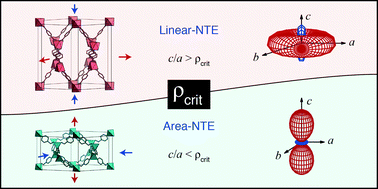Geometric switching of linear to area negative thermal expansion in uniaxial metal–organic frameworks†
Abstract
Using variable-temperature neutron powder diffraction measurements, we show that the two quartz-like metal–organic frameworks (MOFs) deuterium indium(III) terephthalate and zinc(II) isonicotinate exhibit anisotropic positive and negative thermal expansion (PTE/NTE) behaviour. Whereas in the former the NTE response is uniaxial—occurring along the hexagonal crystal axis—this behaviour is inverted in the latter such that PTE occurs along the hexagonal axis and NTE is found in the entire plane of perpendicular directions. We show that this inversion of mechanical response can be explained on geometric grounds alone; specifically, we identify a critical framework geometry that demarcates a switch from linear to area NTE response. Extending this analysis to other common MOF topologies, we establish a generic predictive approach for establishing the dimensionality of NTE (or, by extension, negative compressibility) responses in a large range of different framework systems. Our analysis suggests that framework geometry plays a crucial role in determining the mechanical response of framework materials which show anisotropic responses via hinging.


 Please wait while we load your content...
Please wait while we load your content...